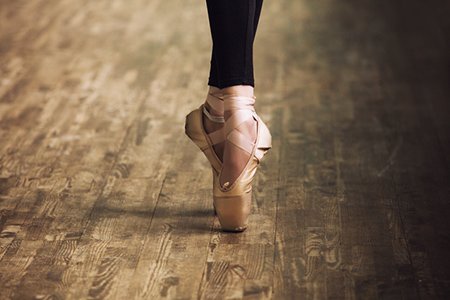Dance Injuries
 Dancers combine strength, flexibility and grace when they perform. And even though they make it all look effortless, dancers are serious athletes who train hard and are prone to a wide range of injuries. At Henry Ford Health, we care for dancers of all skill levels and help you return to your sport safely.
Dancers combine strength, flexibility and grace when they perform. And even though they make it all look effortless, dancers are serious athletes who train hard and are prone to a wide range of injuries. At Henry Ford Health, we care for dancers of all skill levels and help you return to your sport safely.
Dance injury causes
Dancers perform lifts, leaps, acrobatics and other moves that put a great deal of stress on their bodies. Many dancers are still young, which means their bodies aren’t done growing. Long rehearsals, frequent performances and repetitive overuse can lead to a range of injuries in their feet, ankles, knees, legs and back.
Many dancers are extremely flexible. They may overstretch certain soft tissues without having the muscle strength to provide the support they need. This leads to looseness and instability in the joints, which is a frequent cause of pelvic and hip pain in dancers.
People who dance are conscious of how their bodies look and move, which can make them prone to body-image issues. Many dancers are also young adults who may perform at intense levels of competition. Stress, anxiety and eating disorders can arise if dancers push themselves too hard. These issues negatively impact a dancer’s overall health and increase their risk of injuries.
Common dance injuries we treat
Our sports medicine specialists treat a wide range of dance and ballet injuries, including:
- Ankle sprains
- Dancer’s fracture (fracture in the bone that connects your fifth toe to your ankle)
- Foot and ankle tendinitis
- Hip labrum injuries
- Patellofemoral pain syndrome
- Sacroiliac joint dysfunction
- Spondylolysis (stress fractures in the spine)
- Stress fractures in the lower legs
Dance injury treatment
We use a variety of innovative techniques to help you recover from dance injuries, including:
- Blood flow restriction therapy: For some injuries, we place a cuff or elastic band on your arm or leg to reduce blood flow to an injured area. This treatment improves strength by forcing the muscles to work harder to pump blood, but without the stress of added weight.
- Pelvic motion exercises: Physical therapists guide you through pelvic floor training to improve alignment and stability in your hips. We may work with you at a dance barre or during dance routines to ensure you’re properly engaging your core.
- Laser therapy: We may use laser therapy for tendon and ligament injuries. This painless, noninvasive treatment uses light energy to stimulate tissue repair.
- 3D motion analysis: We use video cameras and LED markers to evaluate your body mechanics as you dance. A weight-plated floor measures force and muscle balance when you jump, leap and tumble. This technology at our Center for Athletic Medicine helps our experts determine how your technique could be contributing to injuries.
Most dance injuries improve with nonsurgical treatments. But if you do need surgery, our experts offer a variety of innovative procedures. Whenever possible, we use minimally invasive techniques to help you heal faster and with less pain.
Dance injury prevention
To reduce your risk of dance injuries:
- Eat a balanced diet rich in protein, calcium and vitamin D.
- Know your limits and do not push through pain.
- Do not advance to higher levels of training (such as ballet dancers advancing to pointe) until you have the necessary strength and skeletal maturity.
- Use proper technique, especially for leaps, lifts and landings.
- Warm up and cool down before and after rehearsals and performances.
Dance injury care: Why choose Henry Ford?
At our sports medicine program, you’ll find:
- Full spectrum of care: Our team includes sports medicine physicians, orthopedic surgeons and certified athletic trainers. We work closely with physical therapists, dietitians and behavioral health specialists to ensure dancers get the comprehensive care they need.
- Minimally invasive treatment options: From Tenex procedures to treat Achilles and Patellar tendons to plasma-rich protein (PRP) injections to treat knee injuries there are options available to reduce procedure time, hasten recovery and increase potential for improved outcomes.
- Easy access: Most providers can see you within 24 to 48 hours, so you receive prompt care for your injury. We offer in-person and virtual appointments. We also have walk-in orthopedic clinics with extended evening hours for your convenience.
- Customized treatment: Dance injuries affect everyone differently. We provide thorough, customized assessments for every athlete to uncover the root cause of your injury. Our experts build care plans tailored to your unique needs. You return to dancing safely and with less risk of re-injury.
Explore our blogs
Learn more about sports injuries and injury prevention:
.svg?iar=0&hash=F6049510E33E4E6D8196C26CCC0A64A4)

/hfh-logo-main--white.svg?iar=0&hash=ED491CBFADFB7670FAE94559C98D7798)